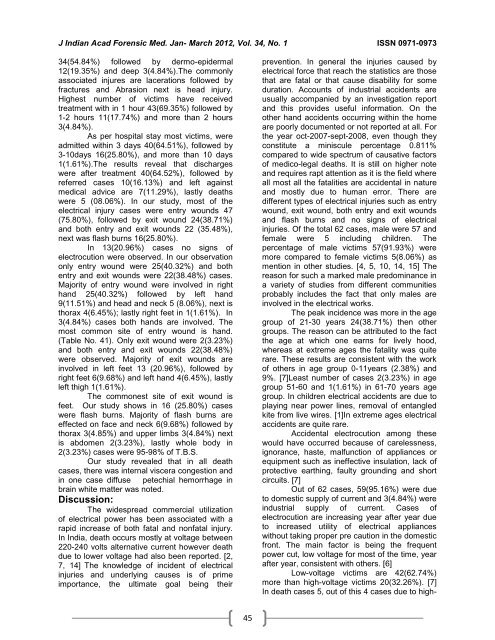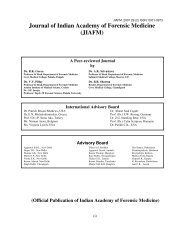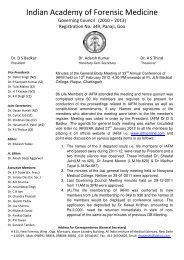Indian Academy of Forensic Medicine (IAFM) - Official website of IAFM
Indian Academy of Forensic Medicine (IAFM) - Official website of IAFM
Indian Academy of Forensic Medicine (IAFM) - Official website of IAFM
Create successful ePaper yourself
Turn your PDF publications into a flip-book with our unique Google optimized e-Paper software.
J <strong>Indian</strong> Acad <strong>Forensic</strong> Med. Jan- March 2012, Vol. 34, No. 1 ISSN 0971-0973<br />
34(54.84%) followed by dermo-epidermal<br />
12(19.35%) and deep 3(4.84%).The commonly<br />
associated injures are lacerations followed by<br />
fractures and Abrasion next is head injury.<br />
Highest number <strong>of</strong> victims have received<br />
treatment with in 1 hour 43(69.35%) followed by<br />
1-2 hours 11(17.74%) and more than 2 hours<br />
3(4.84%).<br />
As per hospital stay most victims, were<br />
admitted within 3 days 40(64.51%), followed by<br />
3-10days 16(25.80%), and more than 10 days<br />
1(1.61%).The results reveal that discharges<br />
were after treatment 40(64.52%), followed by<br />
referred cases 10(16.13%) and left against<br />
medical advice are 7(11.29%), lastly deaths<br />
were 5 (08.06%). In our study, most <strong>of</strong> the<br />
electrical injury cases were entry wounds 47<br />
(75.80%), followed by exit wound 24(38.71%)<br />
and both entry and exit wounds 22 (35.48%),<br />
next was flash burns 16(25.80%).<br />
In 13(20.96%) cases no signs <strong>of</strong><br />
electrocution were observed. In our observation<br />
only entry wound were 25(40.32%) and both<br />
entry and exit wounds were 22(38.48%) cases.<br />
Majority <strong>of</strong> entry wound were involved in right<br />
hand 25(40.32%) followed by left hand<br />
9(11.51%) and head and neck 5 (8.06%), next is<br />
thorax 4(6.45%); lastly right feet in 1(1.61%). In<br />
3(4.84%) cases both hands are involved. The<br />
most common site <strong>of</strong> entry wound is hand.<br />
(Table No. 41). Only exit wound were 2(3.23%)<br />
and both entry and exit wounds 22(38.48%)<br />
were observed. Majority <strong>of</strong> exit wounds are<br />
involved in left feet 13 (20.96%), followed by<br />
right feet 6(9.68%) and left hand 4(6.45%), lastly<br />
left thigh 1(1.61%).<br />
The commonest site <strong>of</strong> exit wound is<br />
feet. Our study shows in 16 (25.80%) cases<br />
were flash burns. Majority <strong>of</strong> flash burns are<br />
effected on face and neck 6(9.68%) followed by<br />
thorax 3(4.85%) and upper limbs 3(4.84%) next<br />
is abdomen 2(3.23%), lastly whole body in<br />
2(3.23%) cases were 95-98% <strong>of</strong> T.B.S.<br />
Our study revealed that in all death<br />
cases, there was internal viscera congestion and<br />
in one case diffuse petechial hemorrhage in<br />
brain white matter was noted.<br />
Discussion:<br />
The widespread commercial utilization<br />
<strong>of</strong> electrical power has been associated with a<br />
rapid increase <strong>of</strong> both fatal and nonfatal injury.<br />
In India, death occurs mostly at voltage between<br />
220-240 volts alternative current however death<br />
due to lower voltage had also been reported. [2,<br />
7, 14] The knowledge <strong>of</strong> incident <strong>of</strong> electrical<br />
injuries and underlying causes is <strong>of</strong> prime<br />
importance, the ultimate goal being their<br />
45<br />
prevention. In general the injuries caused by<br />
electrical force that reach the statistics are those<br />
that are fatal or that cause disability for some<br />
duration. Accounts <strong>of</strong> industrial accidents are<br />
usually accompanied by an investigation report<br />
and this provides useful information. On the<br />
other hand accidents occurring within the home<br />
are poorly documented or not reported at all. For<br />
the year oct-2007-sept-2008, even though they<br />
constitute a miniscule percentage 0.811%<br />
compared to wide spectrum <strong>of</strong> causative factors<br />
<strong>of</strong> medico-legal deaths. It is still on higher note<br />
and requires rapt attention as it is the field where<br />
all most all the fatalities are accidental in nature<br />
and mostly due to human error. There are<br />
different types <strong>of</strong> electrical injuries such as entry<br />
wound, exit wound, both entry and exit wounds<br />
and flash burns and no signs <strong>of</strong> electrical<br />
injuries. Of the total 62 cases, male were 57 and<br />
female were 5 including children. The<br />
percentage <strong>of</strong> male victims 57(91.93%) were<br />
more compared to female victims 5(8.06%) as<br />
mention in other studies. [4, 5, 10, 14, 15] The<br />
reason for such a marked male predominance in<br />
a variety <strong>of</strong> studies from different communities<br />
probably includes the fact that only males are<br />
involved in the electrical works.<br />
The peak incidence was more in the age<br />
group <strong>of</strong> 21-30 years 24(38.71%) then other<br />
groups. The reason can be attributed to the fact<br />
the age at which one earns for lively hood,<br />
whereas at extreme ages the fatality was quite<br />
rare. These results are consistent with the work<br />
<strong>of</strong> others in age group 0-11years (2.38%) and<br />
9%. [7]Least number <strong>of</strong> cases 2(3.23%) in age<br />
group 51-60 and 1(1.61%) in 61-70 years age<br />
group. In children electrical accidents are due to<br />
playing near power lines, removal <strong>of</strong> entangled<br />
kite from live wires. [1]In extreme ages electrical<br />
accidents are quite rare.<br />
Accidental electrocution among these<br />
would have occurred because <strong>of</strong> carelessness,<br />
ignorance, haste, malfunction <strong>of</strong> appliances or<br />
equipment such as ineffective insulation, lack <strong>of</strong><br />
protective earthing, faulty grounding and short<br />
circuits. [7]<br />
Out <strong>of</strong> 62 cases, 59(95.16%) were due<br />
to domestic supply <strong>of</strong> current and 3(4.84%) were<br />
industrial supply <strong>of</strong> current. Cases <strong>of</strong><br />
electrocution are increasing year after year due<br />
to increased utility <strong>of</strong> electrical appliances<br />
without taking proper pre caution in the domestic<br />
front. The main factor is being the frequent<br />
power cut, low voltage for most <strong>of</strong> the time, year<br />
after year, consistent with others. [6]<br />
Low-voltage victims are 42(62.74%)<br />
more than high-voltage victims 20(32.26%). [7]<br />
In death cases 5, out <strong>of</strong> this 4 cases due to high-









